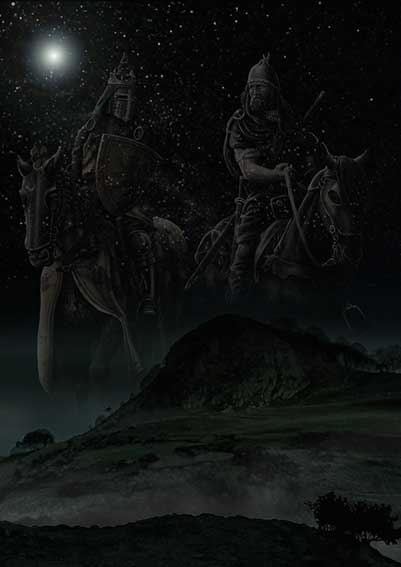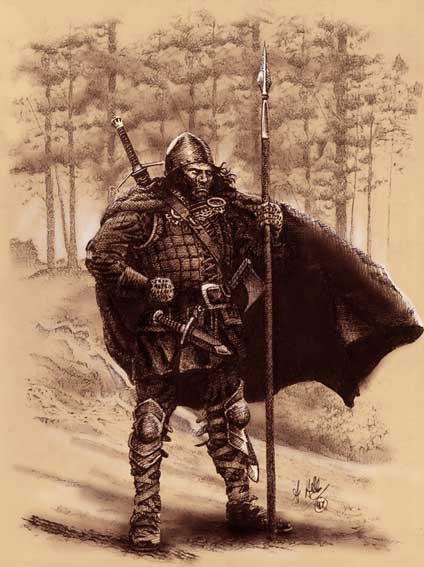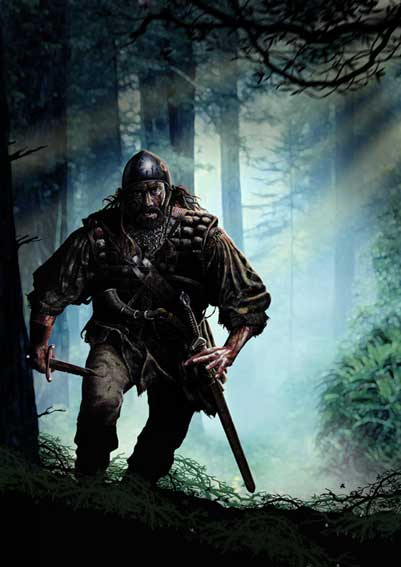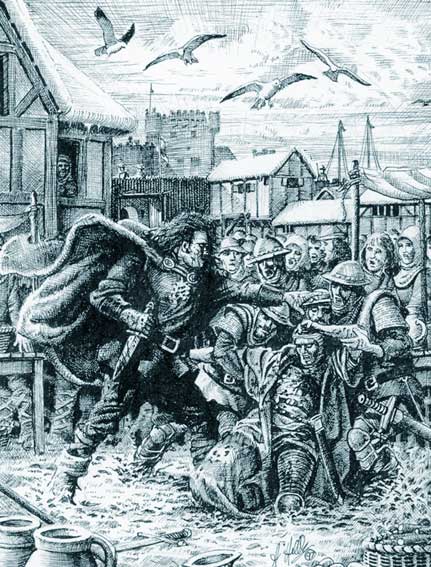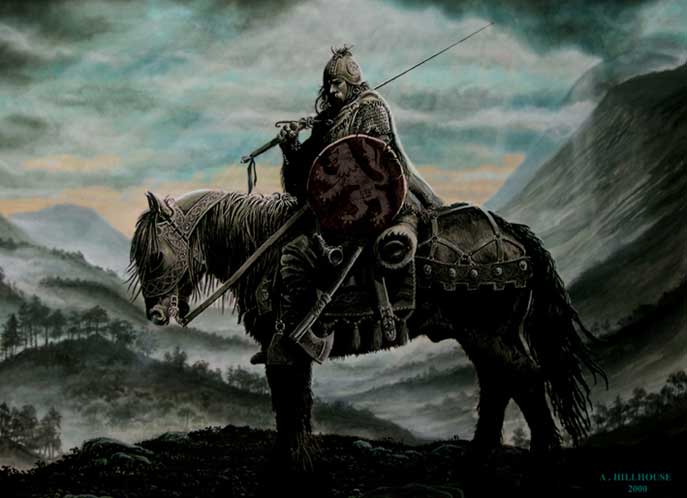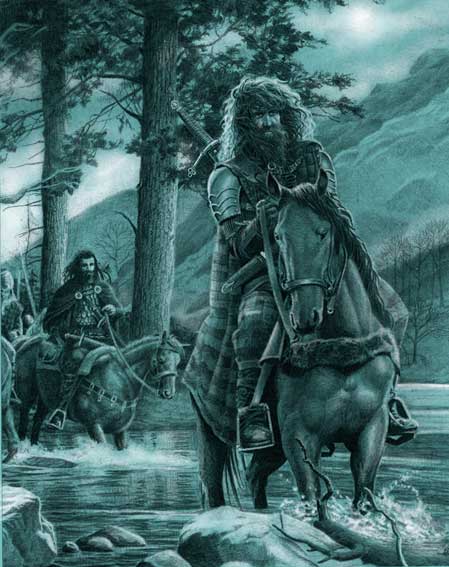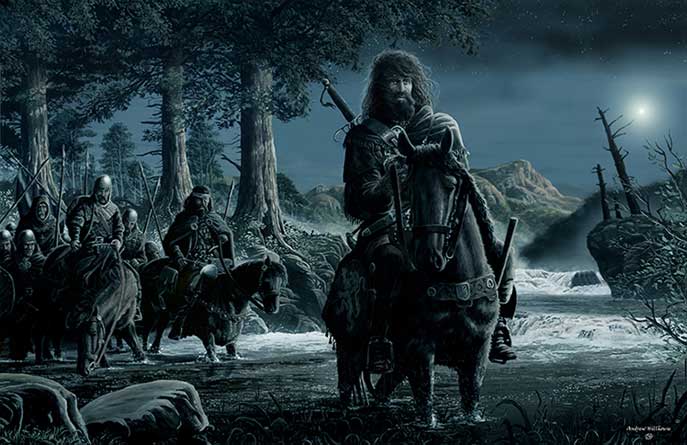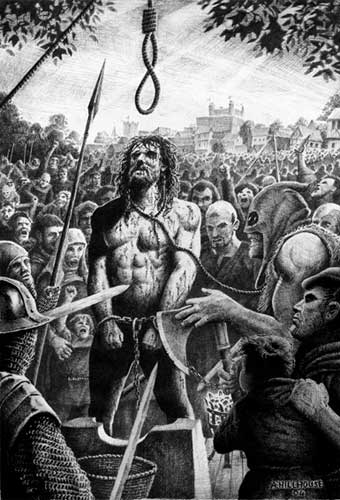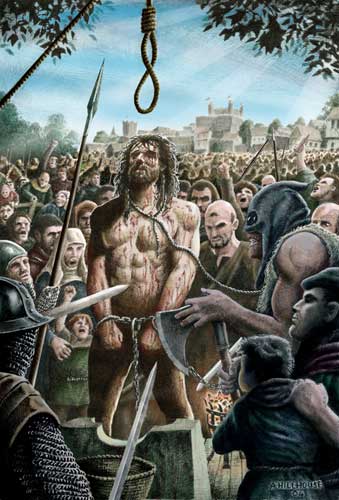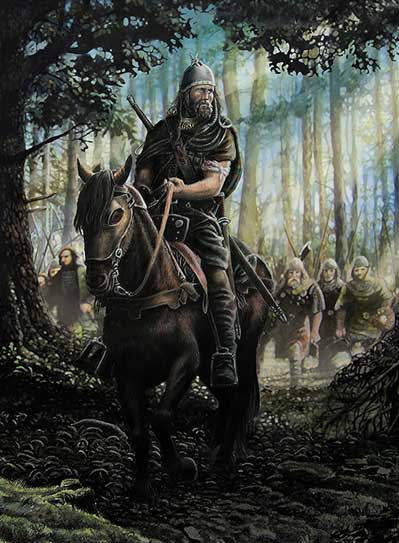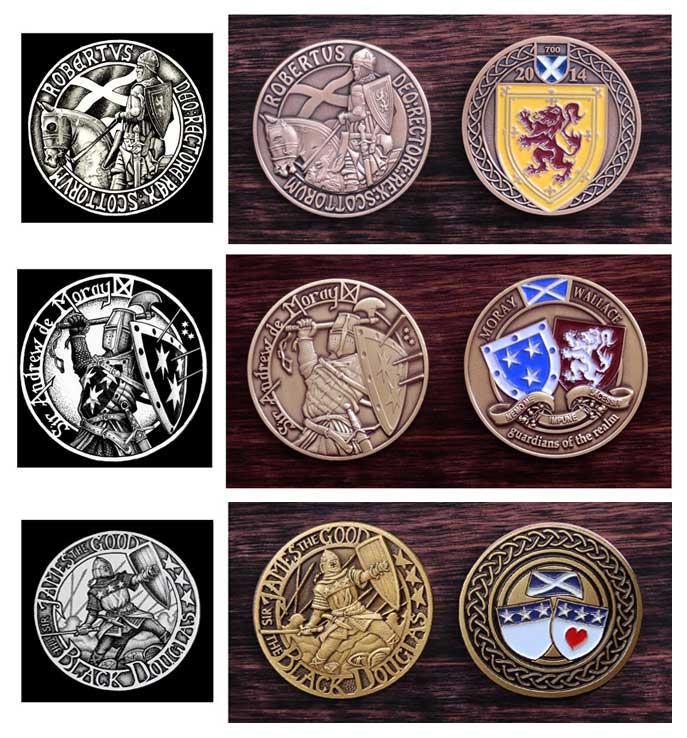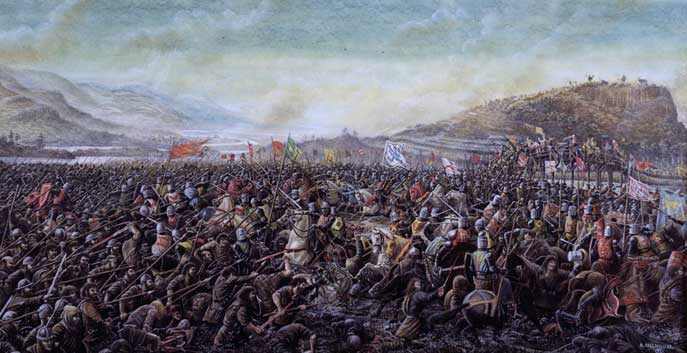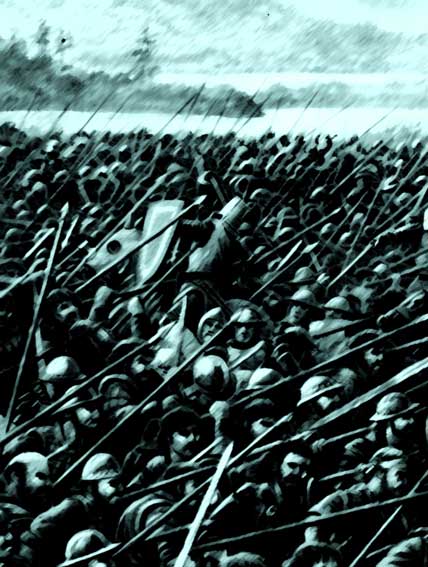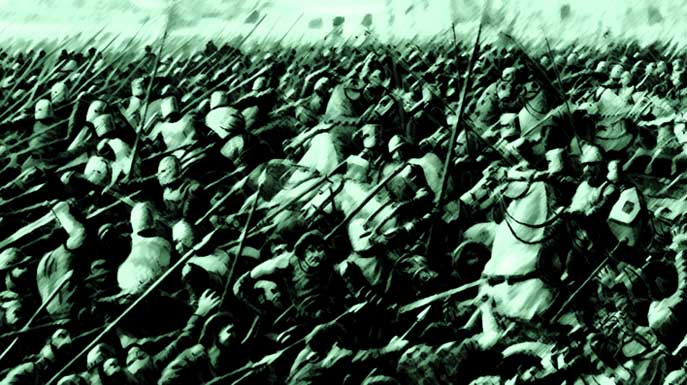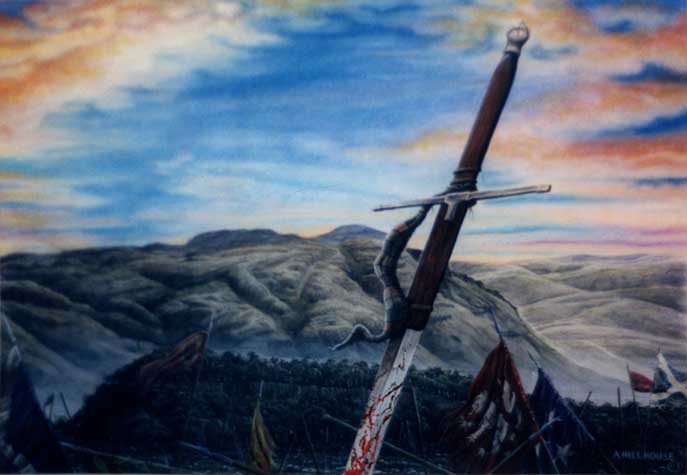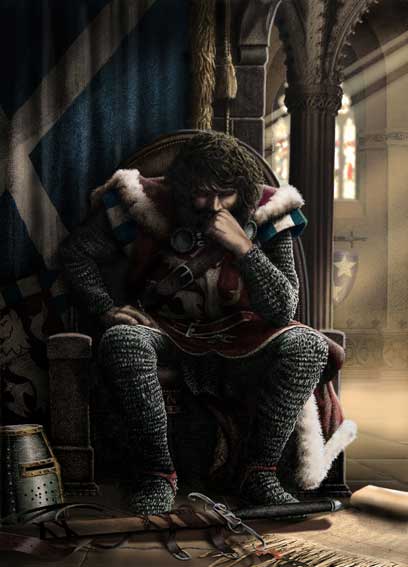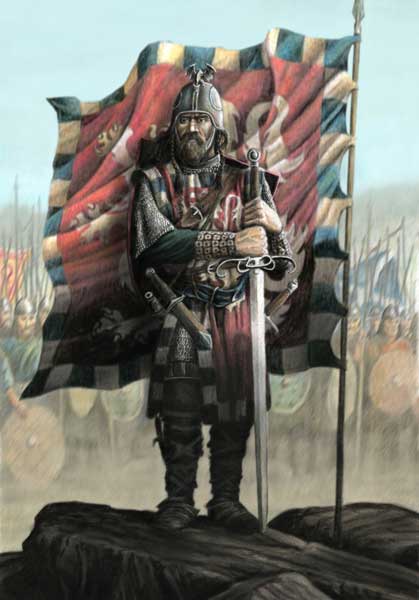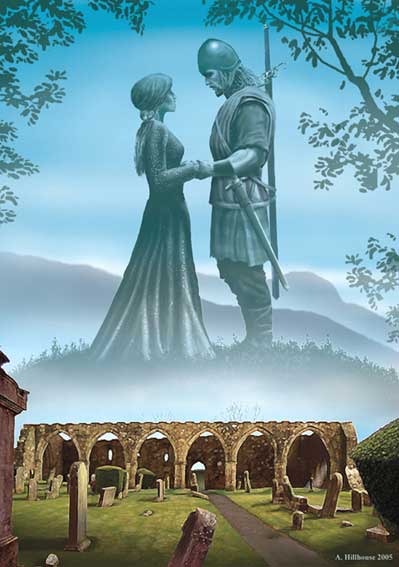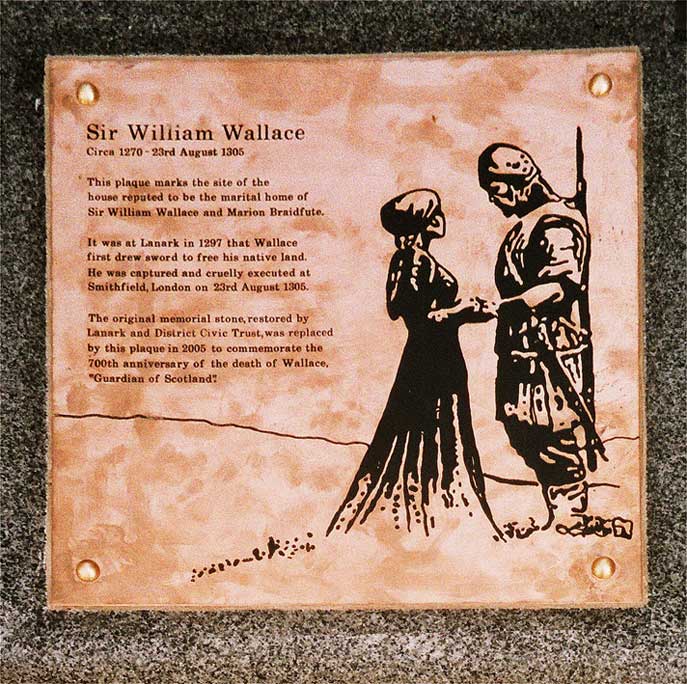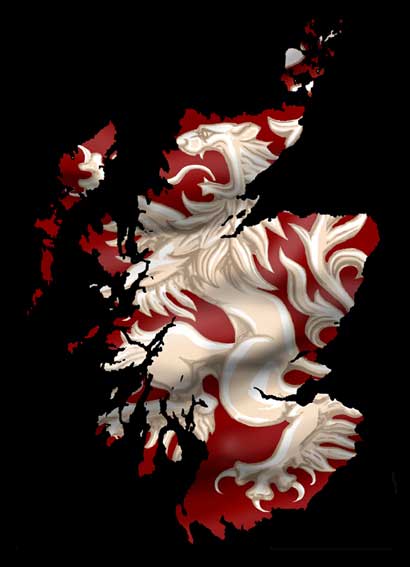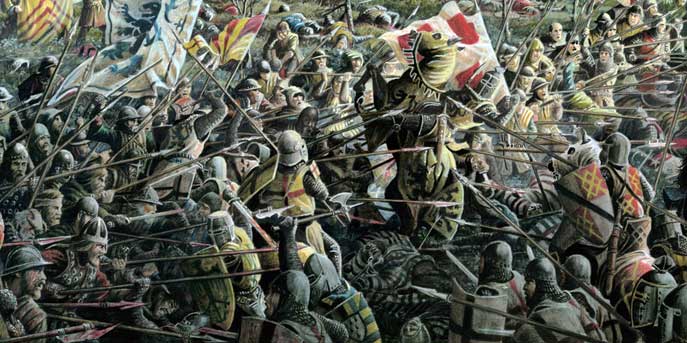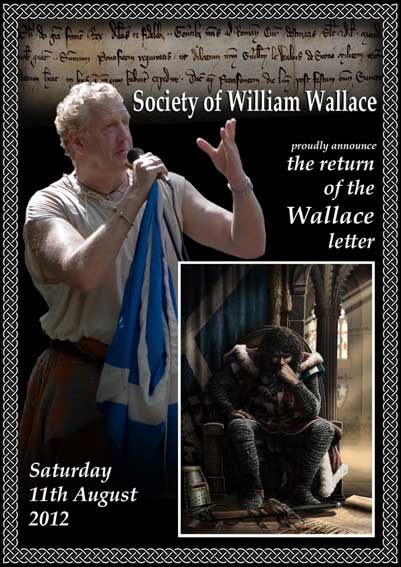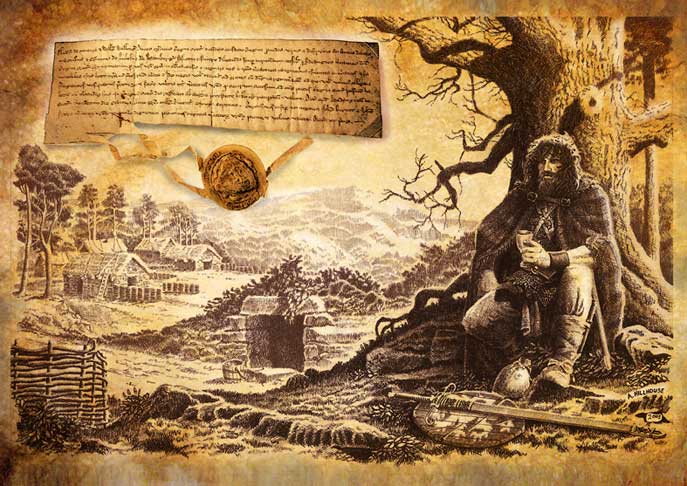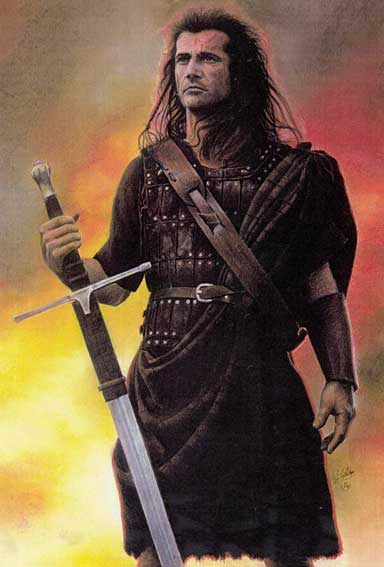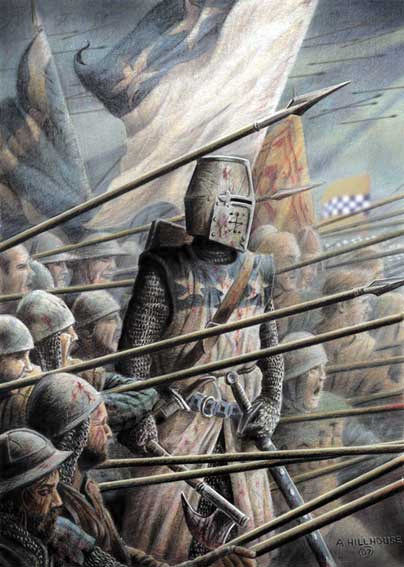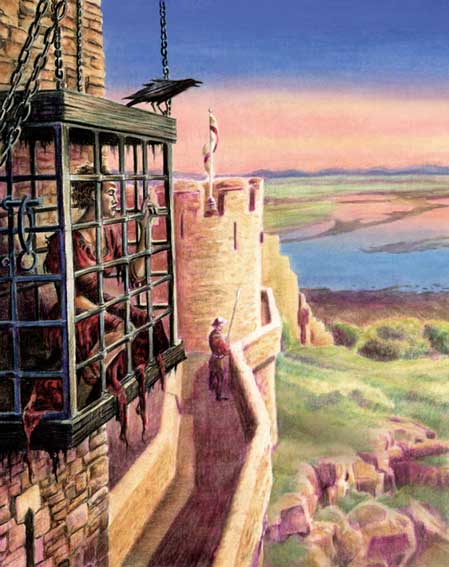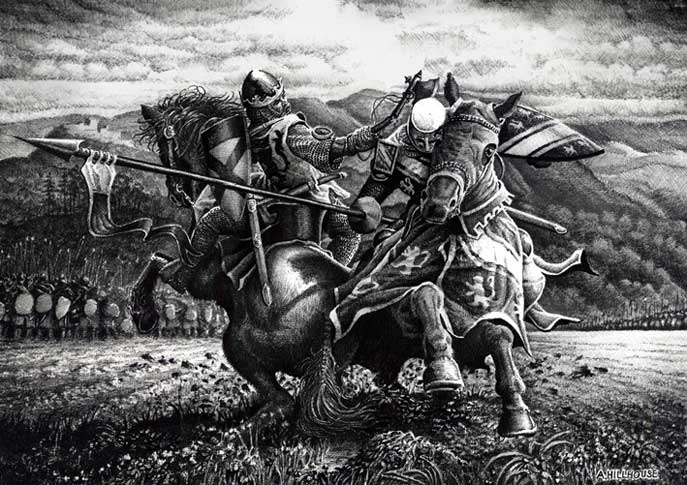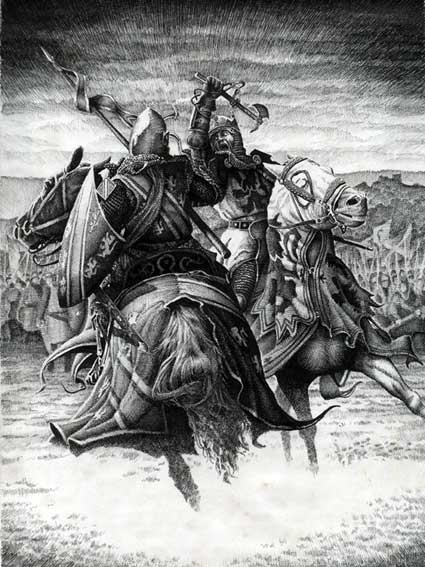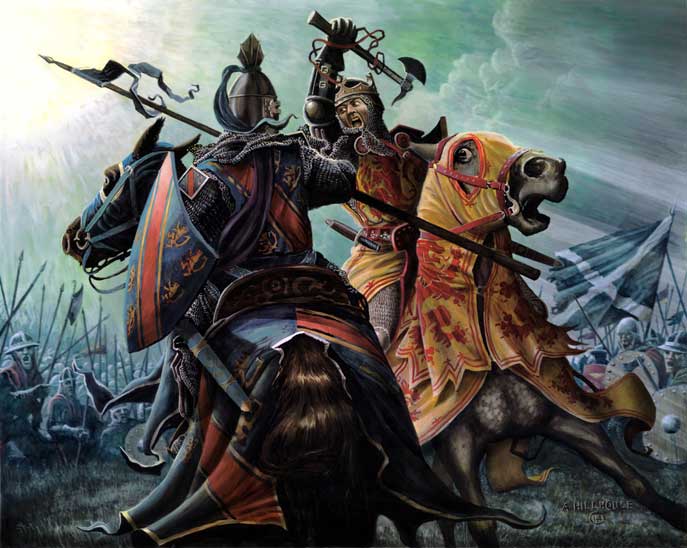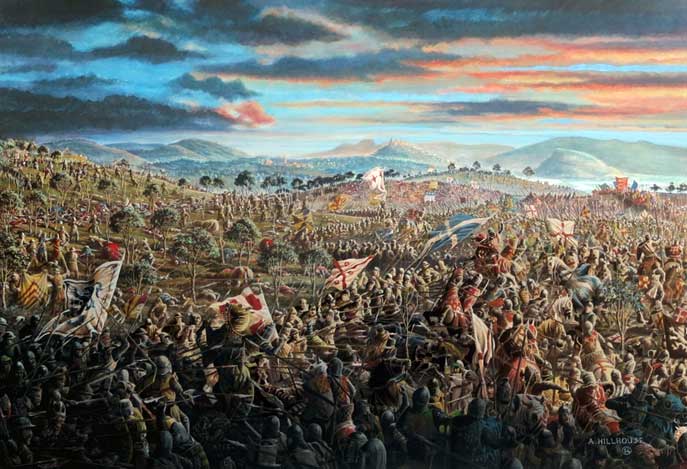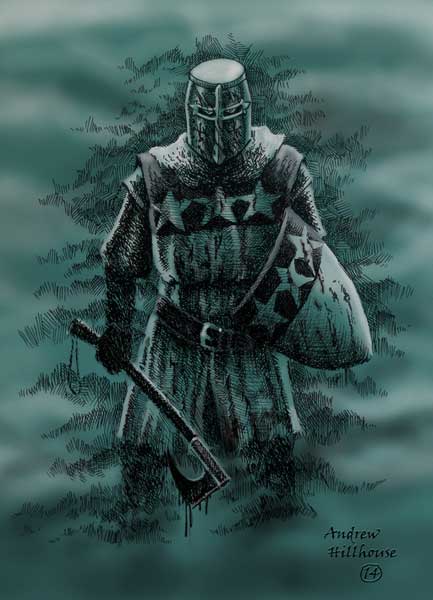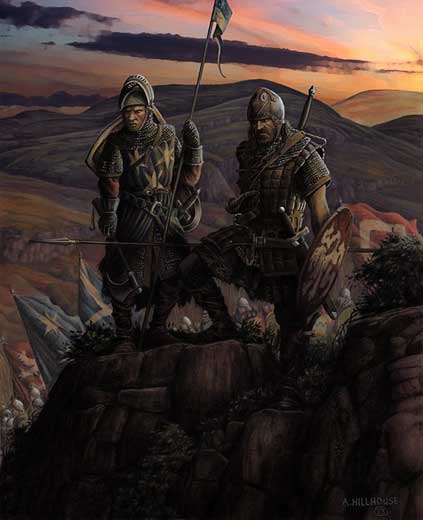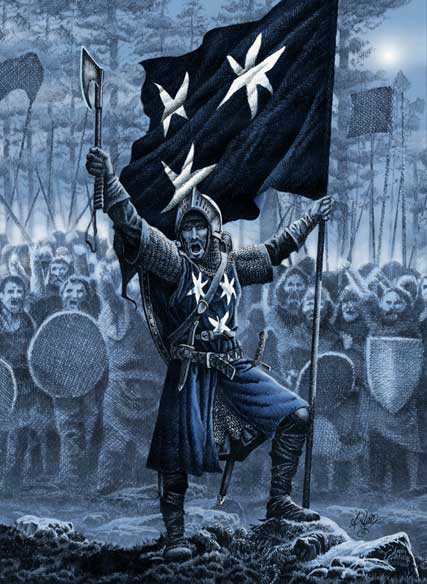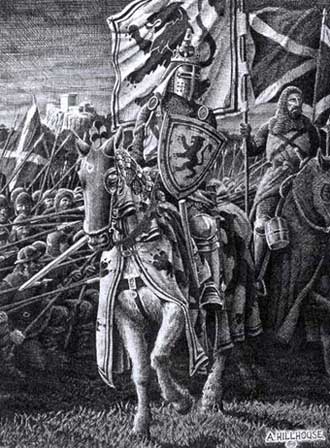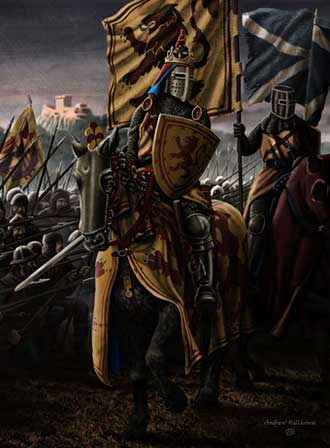
WALLACE / BRUCE IMAGE GALLERY BY ANDY HILLHOUSE
Andrew worked as a technician in the School of Landscape Architecture, ESALA, Edinburgh University. He drew, painted and illustrated in his spare time depicting, predominantly but not exclusively, various periods of Scottish history. Much of the work on this page has been used for book covers, internal illustrations, cd covers, advertisements, publicity, marketing and campaign material.
|
All work copyright of Andrew Hillhouse. |
| |
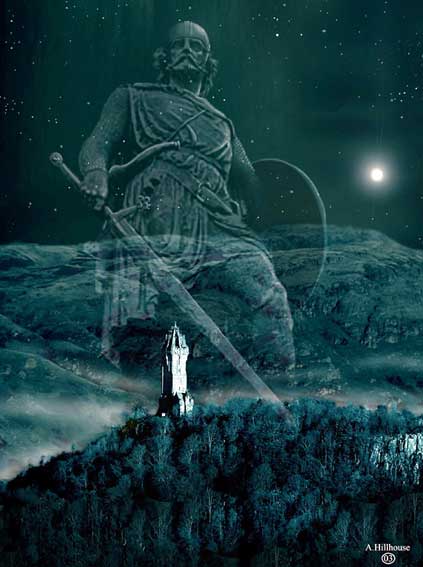 |
The Spirit of Wallace
Facing south, the Spirit of William Wallace stands guard over the Abbey Craig. |
| |
|
William Wallace - Loudoun Hill
In the summer of 1296, Wallace avenged the death of his father at Loudoun Hill, Ayrshire, by staging an ambush at the same location. This was the first time he led a force of men, all close friends or family. |
| |
William Wallace
An ink rendering of William Wallace and Andrew de Moray leading the Scottish army towards Stirling. |
|
|
William Wallace - March on Stirling Bridge
The combined forces of William Wallace and Andrew de Moray take position upon the Abbey Craig near Stirling, nervously awaiting victory or death against the oncoming English army. |
| |
|
Death of the Black Douglas
Sir James, the Black, Douglas was killed in battle against the Moors at Teba, Andalucia, August 25th, 1330, whilst carrying the embalmed heart of his friend, king Robert the Bruce, to the holy land. A monument to his life and achievements was built in Teba, where they still celebrate an annual Douglas day. In Scotland, his exploits are barely known. |
| |
|
|
Robert the Bruce
An ink rendering of Robert the Bruce marshalling his forces on the second day of the Battle of Bannockburn. |
Robert the Bruce
A colour rendering of Robert the Bruce marshalling his forces on the second day of the Battle of Bannockburn. |
| |
|
Ghosts of Loudoun Hill
Both Wallace and Bruce fought successful battles here at Loudoun Hill, Ayrshire, at the start of their respective campaigns.
|
|
| |
|
William Wallace - Guerrilla
An ink sketch of the equipment Wallace may have carried circa late 1296. |
William Wallace - Outlaw
Prior to becoming a guerrilla leader, Wallace was a wanted man who haunted the vast forests of central Scotland, attacking English interests at will. |
|
|
William Wallace - The Selby incident
One of the earliest incidents involving William Wallace, circa December 1291. Accosted in the street by young Selby, the son of the constable of Dundee, Wallace’s retaliation was swift and lethal. |
|
William Wallace – Shadow Warrior
In the early summer of 1297, William Wallace led a force of Scottish patriots north to defeat a numerically superior war band of Irish mercenaries loyal to the English king. Here he contemplates tactics at the Pass of Brander, near Loch Awe. |
William Wallace - Loudoun Hill Gang sketch
A pencil sketch which ultimately evolved into a painting. |
|
William Wallace - Loudoun Hill gang
In the summer of 1296 Wallace assembled a small force of family members and close friends who set out to avenge the death of his father. They subsequently routed a heavily armoured English convoy at Loudoun Hill. This was the first time that Wallace had commanded a body of men. |
|
|
William Wallace - Execution
On 23rd August 1305, William Wallace was brutally executed at Smithfield, London. |
William Wallace - Execution - colour
A colour rendering of the previous image. |
|
William Wallace - Perth campaign
In the latter half of 1296, Wallace led a motely bunch of disaffected bandits and fugitives in a series of hit and run raids across Perthshire before melting away again into the surrounding forests with captured arms, equipment and booty. |
|
Commemorative Coins
Three commemorative coins commissioned and drawn exclusively for, and merchandised by, the Society of William Wallace, we have Robert the Bruce, Andrew DeMoray Sir James (the Black) Douglas.
|
|
William Wallace - Battle of Stirling Bridge
On the morning of September 11th 1297, the combined Scottish forces of William Wallace and Andrew de Moray inflicted a devastating defeat upon the numerically superior English army on the boggy ground at the bridge over the River Forth near Stirling. |
William Wallace
Battle of Stirling Bridge
detail 1 |
|
|
William Wallace - Battle of Stirling Bridge – detail 2 |
|
William Wallace – Aftermath
With the Abbey Craig in the background, the flags of William Wallace and Andrew de Moray hang limp amidst the carnage of the aftermath of the Battle of Stirling Bridge. |
|
Sir William Wallace -
Guardian of the Realm
In late 1297, William Wallace was knighted and proclaimed Guardian of the Realm along with Andrew de Moray. Soon, however, de Moray was dead from wounds received at Stirling Bridge and Wallace had to rule a troubled, disunited kingdom alone. |
|
Wallace at Falkirk
How Wallace may have appeared, as Guardian of the Realm, before the disastrous Battle of Falkirk, 1298. |
|
| |
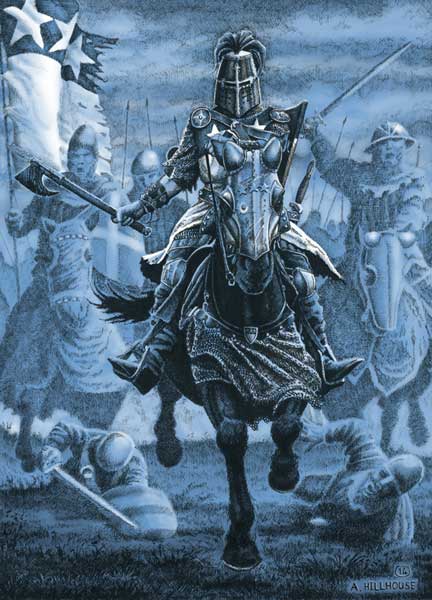
|
Black Douglas Raid
Sir James Douglas leads another raid across the border.
|
William Wallace -
Spirit of Lanark
Wallace is depicted with his wife, Marion Braidfute, above the ruins of St Kentigern’s chapel. Tradition dictates that the pair were married at this location.
|
|
|
Spirit of Lanark memorial plaque
The Spirit of Lanark image was used as a memorial plaque to commemorate the location of Wallace’s house in the town. |
|
Society of William Wallace Design
A design combining the Wallace crest with the outline of Scotland, created for the Society of William Wallace. |
|
"detail of the Battle of Bannockburn painting"
A close up of the battle image showing the hand to hand nature of medieval warfare.
|
Society of William Wallace leaflet
A leaflet commemorating the return to Scotland of the Wallace letter after years of tireless campaigning by the Society of William Wallace. |
|
|
William Wallace – Robroyston
A publicity image created to aid a campaign that saved the well at Robroyston from destruction by property developers. Tradition dictates that this was the well where Wallace refreshed himself before his betrayal and capture at Robroyston in 1305. |
|
Gibson’s Wallace
A mixed media depiction of the patriot in the film “Braveheart”. |
The Black Douglas
Sir James, “the good” or “the black” Douglas directs the left wing of the Scottish army on the second day of the Battle of Bannockburn, Monday 24th June, 1314. |
|
|
Isabella, Countess of Buchan
In retaliation for her support of the Bruce cause, the English King had Isabella Macduff, countess of Buchan, suspended outdoors in an open air cage from the walls of Berwick for four years so “that both in life and after her death, she may be a spectacle and eternal reproach to travellers”. |
|
Robert the Bruce and Henry de Bohun
The Bruce kills the English knight, Henry de Bohun, in single combat on the first day of the battle of Bannockburn. |
|
Work in Progress, the Bruce and de Bohun ink sketch
A reworking of the previous image, used as a sketch for a painting. |
|
Bruce and de Bohun
First day of the battle, 23rd June, 1314. Robert the Bruce slays the English knight, Henry de Bohun, in single combat. This dramatic event significantly raised the Scottish army's morale and dashed that of the English army.
|
|
Battle of Bannockburn
Second day of the battle, 24th June, 1314. Bruce's schiltrons finally break the ranks of English cavalry after extremely fierce combat.
|
Black Douglas
Sir James Douglas' fearsome reputation in battle swiftly made him "the bogeyman"of many settlements in the north of England.
|
|
|
|
DeMoray & Wallace
on top of Abbey Craig
Sept 11th, 1297. As the English army take up positions on the southern banks of the River Forth at Stirling Bridge, Andrew de Moray and William Wallace, joint commanders of the Scottish army, move their forces into position from atop the nearby Abbey Craig.
|
| |
Andrew de Moray
Andrew de Moray raises the standard at Avoch, 1297
|
|
Back to Top
| © Society of William Wallace 2007-2025 |
The Society of William Wallace is a Scottish Charitable Incorporated Organisation Registration number SC045959 |
|

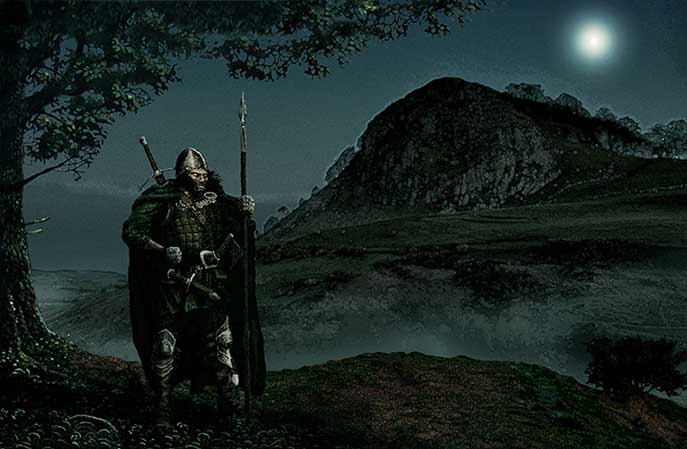
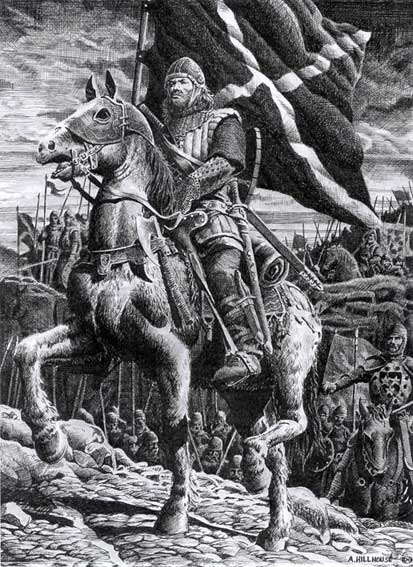
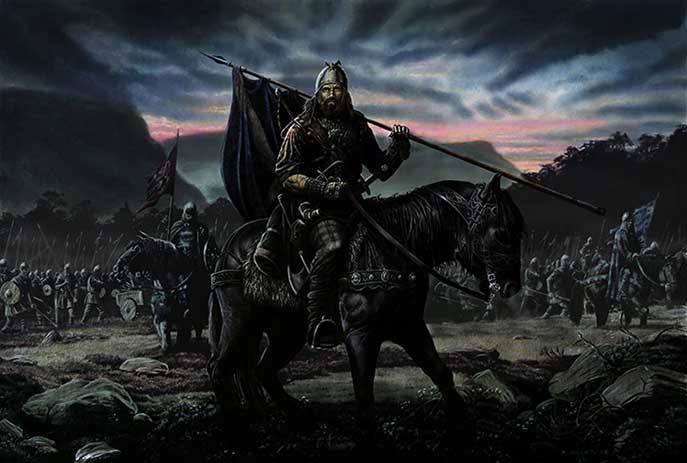
.jpg)
